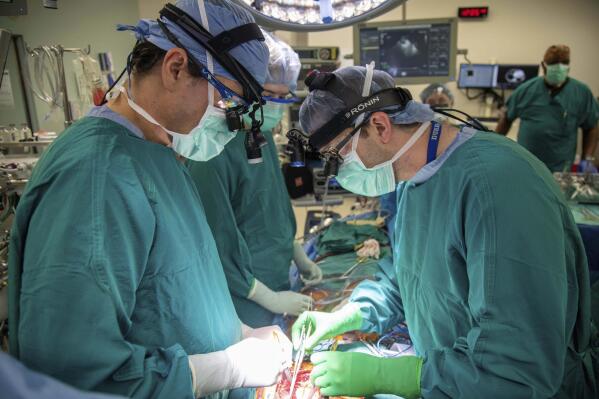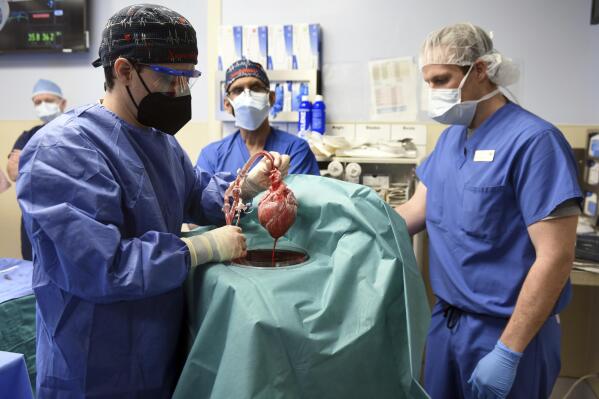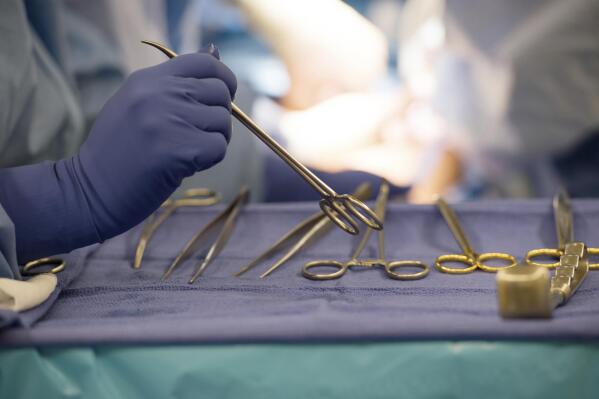Surgeons have performed the world’s first eye transplant
An Arkansas man received the world’s first transplant of a human eye after electrical burns destroyed most of his face and one eye. Surgeons at NYU Langone Health said his new eye appears healthy. It’s too soon to know if he will gain sight.
NEW YORK (AP) — Surgeons have performed the world’s first transplant of an entire human eye, an extraordinary addition to a face transplant — although it’s far too soon to know if the man will ever see through his new left eye.
An accident with high-voltage power lines had destroyed most of Aaron James’ face and one eye. His right eye still works. But surgeons at NYU Langone Health hoped replacing the missing one would yield better cosmetic results for his new face, by supporting the transplanted eye socket and lid.
The NYU team announced Thursday that so far, it’s doing just that. James is recovering well from the dual transplant last May and the donated eye looks remarkably healthy.
“It feels good. I still don’t have any movement in it yet. My eyelid, I can’t blink yet. But I’m getting sensation now,” James told The Associated Press as doctors examined his progress recently.
“You got to start somewhere, there’s got to be a first person somewhere,” added James, 46, of Hot Springs, Arkansas. “Maybe you’ll learn something from it that will help the next person.”
Today, transplants of the cornea — the clear tissue in front of the eye — are common to treat certain types of vision loss. But transplanting the whole eye — the eyeball, its blood supply and the critical optic nerve that must connect it to the brain — is considered a moonshot in the quest to cure blindness.
Whatever happens next, James’ surgery offers scientists an unprecedented window into how the human eye tries to heal.
“We’re not claiming that we are going to restore sight,” said Dr. Eduardo Rodriguez, NYU’s plastic surgery chief, who led the transplant. “But there’s no doubt in my mind we are one step closer.”
Some specialists had feared the eye would quickly shrivel like a raisin. Instead, when Rodriguez propped open James’ left eyelid last month, the donated hazel-colored eye was as plump and full of fluid as his own blue eye. Doctors see good blood flow and no sign of rejection.
Now researchers have begun analyzing scans of James’ brain that detected some puzzling signals from that all-important but injured optic nerve.
One scientist who has long studied how to make eye transplants a reality called the surgery exciting.
“It’s an amazing validation” of animal experiments that have kept transplanted eyes alive, said Dr. Jeffrey Goldberg, chair of ophthalmology at Stanford University.
The hurdle is how to regrow the optic nerve, although animal studies are making strides, Goldberg added. He praised the NYU team’s “audacity” in even aiming for optic nerve repair and hopes the transplant will spur more research.
“We’re really on the precipice of being able to do this,” Goldberg said.
James was working for a power line company in June 2021 when he was shocked by a live wire. He nearly died. Ultimately he lost his left arm, requiring a prosthetic. His damaged left eye was so painful it had to be removed. Multiple reconstructive surgeries couldn’t repair extensive facial injuries including his missing nose and lips.
James pushed through physical therapy until he was strong enough to escort his daughter Allie to a high school homecoming ceremony, wearing a face mask and eye patch. Still he required breathing and feeding tubes, and longed to smell, taste and eat solid food again.
“In his mind and his heart, it’s him — so I didn’t care that, you know, he didn’t have a nose. But I did care that it bothered him,” said his wife, Meagan James.
Face transplants remain rare and risky. James’ is only the 19th in the U.S., the fifth Rodriguez has performed. The eye experiment added even more complexity. But James figured he’d be no worse off if the donated eye failed.
Three months after James was placed on the national transplant waiting list, a matching donor was found. Kidneys, a liver and pancreas from the donor, a man in his 30s, saved three other people.
During James’ 21-hour operation, surgeons added another experimental twist: When they spliced together the donated optic nerve to what remained of James’ original, they injected special stem cells from the donor in hopes of spurring its repair.
This combination of photos provided by NYU Langone Health in November 2023 shows Aaron James before and after his high-voltage electricity accident and after a facial and eye transplant. The NYU team announced Thursday, Nov. 9, 2023, that so far, James is recovering well from the dual transplant in May and the donated eye looks remarkably healthy. (NYU Langone Health via AP)
Last month, tingles heralded healing facial nerves. James can’t yet open the eyelid, and wears a patch to protect it. But as Rodriguez pushed on the closed eye, James felt sensation — although on his nose rather than his eyelid, presumably until slow-growing nerves get reoriented. The surgeon also detected subtle movements beginning in muscles around the eye.
Then came a closer look. NYU ophthalmologist Dr. Vaidehi Dedania ran a battery of tests. She found expected damage in the light-sensing retina in the back of the eye. But she said it appears to have enough special cells called photoreceptors to do the job of converting light to electrical signals, one step in creating vision.
Normally, the optic nerve then would send those signals to the brain to be interpreted. James’ optic nerve clearly hasn’t healed. Yet when light was flashed into the donated eye during an MRI, the scan recorded some sort of brain signaling.
That both excited and baffled researchers, although it wasn’t the right type for vision and may simply be a fluke, cautioned Dr. Steven Galetta, NYU’s neurology chair. Only time and more study may tell.
Still, the surgery marks “a technical tour de force,” said Dr. David Klassen, chief medical officer of the United Network for Organ Sharing, which runs the nation’s transplant system. “You can learn a tremendous amount from a single transplant” that could propel the field.
As for James, “we’re just taking it one day at a time,” he said.
___
The Associated Press Health and Science Department receives support from the Howard Hughes Medical Institute’s Science and Educational Media Group. The AP is solely responsible for all content.



